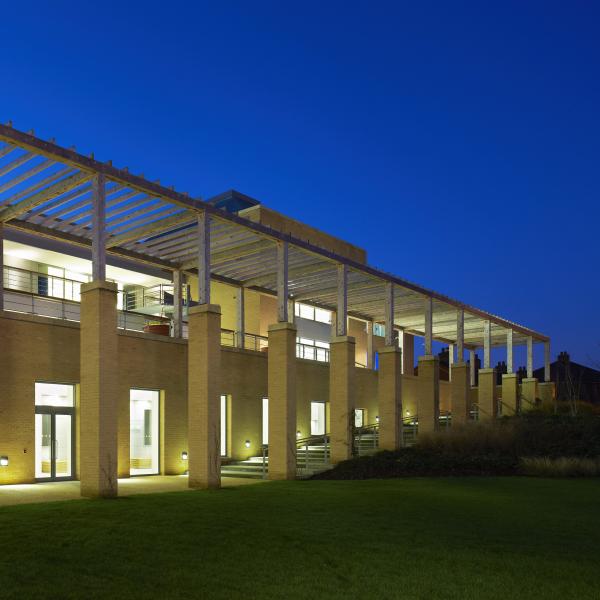Charles Haddad, General Manager of L’Oréal Luxe Middle East, has given the latest Distinguished Speaker Seminar.
It must have been the first time that the seminar had concluded with members of the audience standing around the lecture theatre sniffing at strips of cardboard. In fact, they were so absorbed in this activity that host Professor Andrew Stephen had a hard time herding everyone into the atrium for drinks. Charles Haddad’s talk centring on the Middle East fragrances market had become irresistibly 4D.
Anyone who worries that globalisation has led to bland homogeneity across all markets has clearly not come across the luxury beauty sector in the Middle East. Haddad described a complex and fascinating market with many changes and opportunities still to come.
Market overview
The total beauty market in the Middle East is big – roughly $9 billion dollars. The GCC (Gulf Cooperation Council) countries of Bahrain, Kuwait, Oman, Qatar, Saudi Arabia, and United Arab Emirates make up 63% of the entire market, despite forming only 23% of the population. There is an unusual emphasis on luxury goods: in most parts of the world, luxury products account for only 20 to 25% of the market: in UAE it is 34%.
Haddad reminded the audience of the ‘tremendous transformation’ of the area as ‘big economic plans’ are begin put into practice to reduce the dependency on oil. There is a lot of international investment, a lot of major international events, and a lot of tourism of different types.
The lives of local consumers are changing dramatically as societies become more open, and particularly as women gain more freedoms. ‘New consumers will consume more and in a different way,’ predicted Haddad.
Who are the consumers?
No two of the GCC countries are the same when it comes to consumers. In Saudi Arabia, for example, 79% of people living there are Saudi: in UAE, especially Dubai, Chinese and Russian tourists rub shoulders with a large ex-pat community and, of course, local people with high purchasing power.
What they do have in common is the youth of their populations. 60% of people living in the GCC are Millennials, and with all the characteristics we associate with that generation: savvy, expert, demanding, privileging experiences over products alone. Personalisation is king, though Haddad said that brands are still important too. Rather confusingly, the consumers ‘want uniqueness, but with the big brands.’
Unsurprisingly, these young consumers also form one of most connected populations in the world. With more than one mobile phone per person they are avid consumers of social media and particularly video online. ‘Influencers’ are huge celebrities and a big draw at marketing events, where brands work to create exciting experiences and ‘instagrammable moments’.
Shopping
The retail landscape in the region was described by Haddad as ‘Amazing … You see things here that you don’t see anywhere else.’
Everything centres on the malls, which are massive (‘like cities’) and contain everything from internationally famous department stores, to local and regional chains, and traditional individual shops. The environments are dramatic and high quality, and everything starts with exceptionally high service.
Interestingly, for such a connected population, there is little e-commerce at the moment. Haddad suggested that this was partly to do with the fact that going to the mall has become part of people’s daily lives, and partly to do with a lack of trust in online payments. Many ecommerce transactions are based on cash on delivery.
However, Amazon has recently invested in the market, acquiring the platform Souq; and there are other platforms, such as Boutiqaat, on which influencers can curate and sell selections of their favourite products.
Fragrances
Fragrances are exceptionally important for the region, with consumers in the Middle East spending annually almost four times as much as their equivalents in the US or Europe. They are rooted in tradition and culture, with the idea that a distinctive fragrance is not only matched to the personality of the wearer but to their social status, creating a sense of belonging and pride. Both men and women endeavour to create a ‘unique signature’, often layering and mixing different scents designed for both men and women.
Although famous brands and scents do very well, fragrances made in the region make up 59% of the market. Often based on Oud oil, they are very different from the lighter scents more generally popular elsewhere. Fragrance is also given as a gift on many occasions, from weddings and birthdays to returning from travelling.
Challenges for the future
As e-commerce develops, how will L’Oreal and other brands deliver the personalised experiences that they now deliver in-store? Haddad talked about the need for websites to develop their own USPs, with pre-launch offers, special editions, and services such as engraving and gift presentation. Delivery has to be fast – in Dubai, some sites boast delivery within two hours. He saw the best opportunities in mixing what is happening online and offline: ‘Maybe you gather in the store to learn something, do a masterclass. Then you order online for delivery within two hours – so you don’t have to carry it home,’ he suggested.
How will L’Oreal continue to work with influencers? Haddad stressed that transparency was the most important factor in working with influencers. It is vital to explain to consumers that influencers recommend products as part of a business relationship. He admitted that the relationships could sometimes be tricky, and that the trend was cooling elsewhere in the world. ‘How long it’s going to last I don’t know. But today it is still quite big in the Middle East so we will work with it for as long as it lasts,’ he said.
